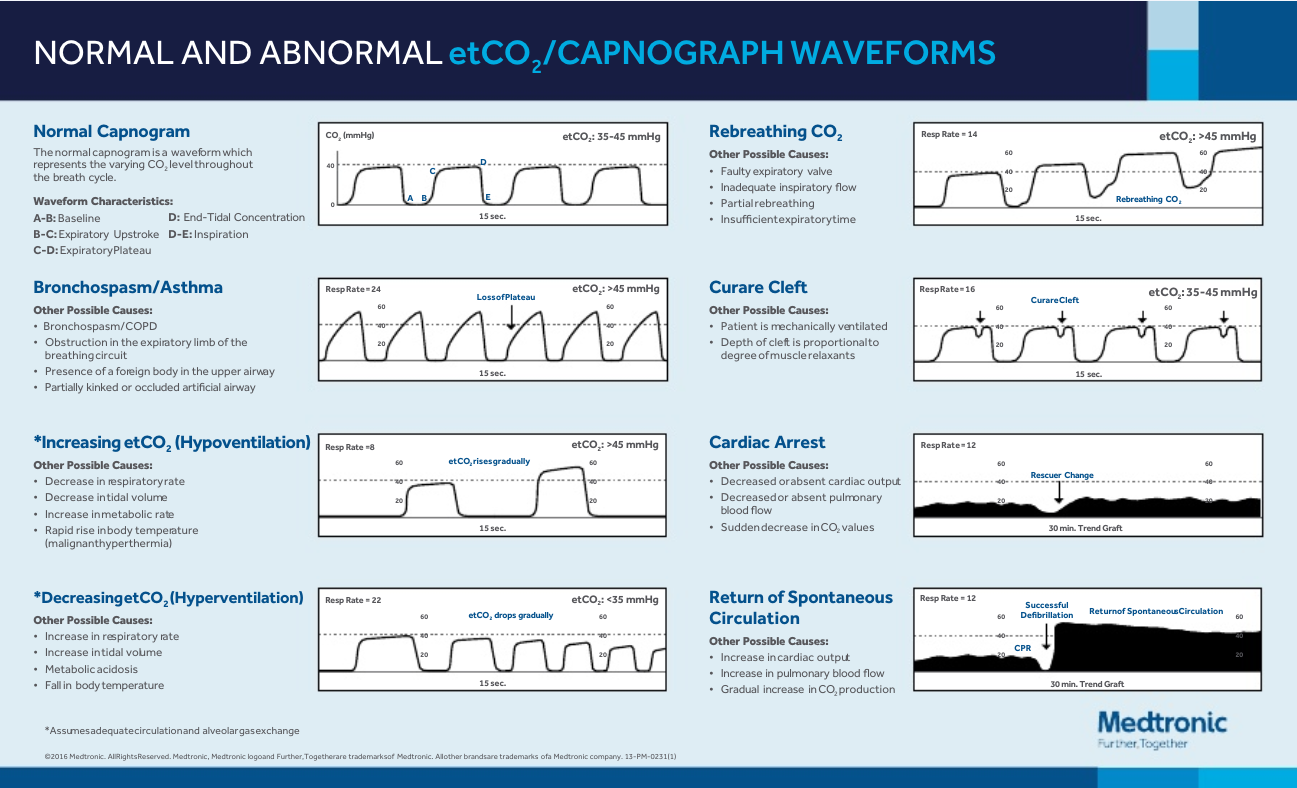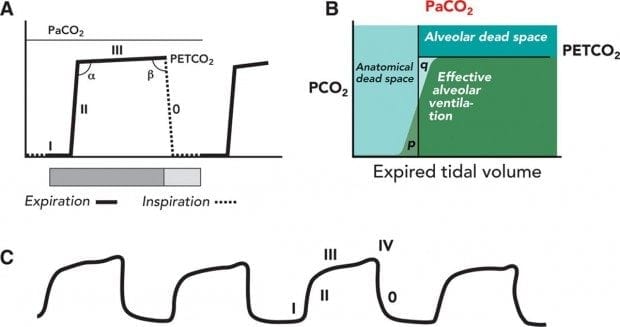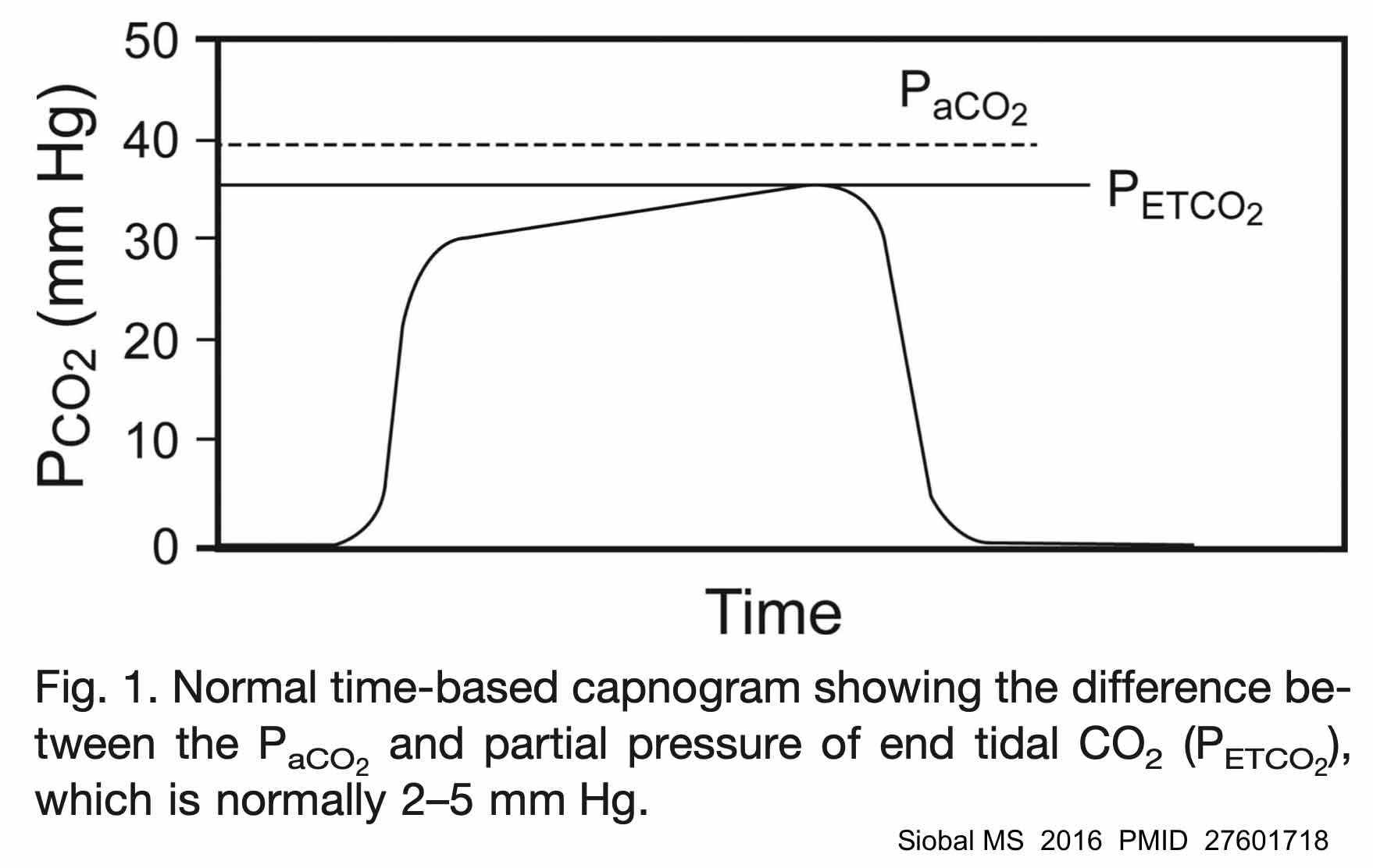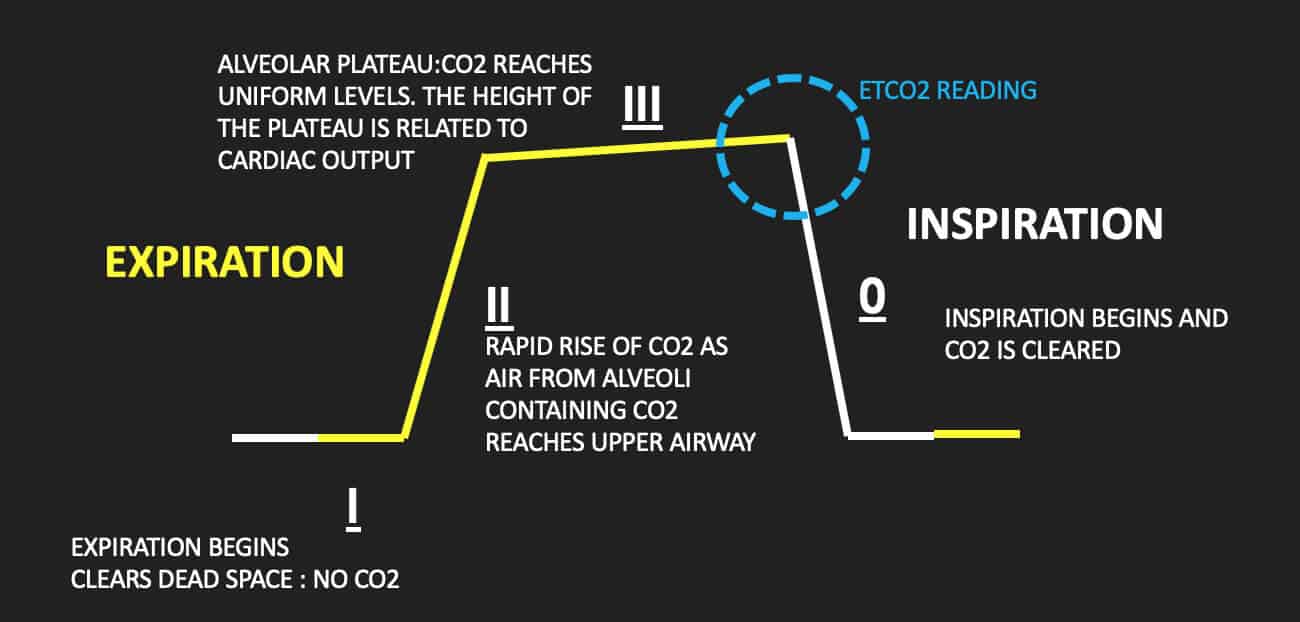end tidal co2 meaning
On average during CPR if adequate chest compressions are being delivered a cardiac index of 16-19 Lminm2 can be generated which correlates with ETCO2 pressures of 20mmHg. Eisenberg and Terry J.

Etco2 Valuable Vital Sign To Assess Perfusion The Airway Jedi
If a person holds his breath the etCO 2 reading is going to show zero no CO2 exhaled.

. However ETCO2 may be underused in the PED setting. End-tidal carbon dioxide. Medical Definition of end-tidal.
The normal values are 5-6 CO2 which is equivalent to 35-45 mmHg. The height of the capnography waveform accompanies this number on the monitor as well as the. An integrated nocturnal CO2 was calculated as the sum of the products of average end-tidal CO2 at each time interval by percent of total sleep time spent at the corresponding time interval.
This is a major respiratory symptom. EtCO 2 reflects cardiac output and pulmonary blood flow as CO 2 is transported by the venous system to the right side of the heart and then pumped to the lungs by the right ventricle as well as the ventilation minute volume Paiva et. End-tidal capnography or end-tidal CO2 EtCO2 monitoring is a non-invasive technique that measures the partial pressure or maximal concentration of carbon dioxide CO2 at the end of an exhaled breath.
Mengert The New England Journal. Deeper slower alveoli are able to share their gas with the capnometer whereas previously that gas would have remained in the airway. 1 ACLS guidelines define high quality chest compressions as.
When CO2 diffuses out of the lungs into the exhaled air a device called a. End-tidal CO2 monitoring is a non-invasive way to monitor a patients carbon dioxide levels. Where the respiratory rate is very low and the tidal volumes are very large the end-tidal CO 2 can be higher than the mean arterial CO 2.
Exhaled carbon dioxide both in terms of its quantity and pattern provides detailed information on the cardiopulmonary system. This is result of a slower expiration. Remains locked to the hemoglobin.
The number is called capnometry which is the partial pressure of CO 2 detected at the end of exhalation ranging between 35 - 45 mm Hg or 40 57 kPa. 45 In this way your EtCO 2 reading can help you better interpret the validity and meaning of. End tidal CO 2 monitoring is represented as a number and a graph on a monitor.
It is usually presented as a graph of CO. Both end-tidal CO2 monitors and pulse oximetry devices work closely together to help monitor the respiratory status of a patient. The amount of CO2 at the end of exhalation or end-tidal CO2 ETCO2 is normally 35-45 mm HG.
Additionally our end tidal CO2 monitor comes equipped with a long-lasting battery pack meaning it can be used in situations where a power source is not readily available. The gradient is the difference between the arterial carbon dioxide partial pressure PaCO 2 and the etCO 2 partial pressure is a result of the relationship between ventilation and perfusion or rather ventilation-perfusion matching VQ. Most medical sources define hypocapnia as less than 35 mm Hg for partial CO2 pressure in the arterial blood.
The integrated nocturnal CO2 was inversely corre-lated with mean post-apnea duration with lesser contributions. It is the standard of care during certain procedures such as intubations and sedations and can be used in variety of clinical situations. Many things must occur for the exhaled carbon dioxide tracing to appear normal fig.
End-tidal carbon dioxide is the partial pressure of carbon dioxide EtCO 2 at the end of an exhaled breath. Edit on Wikidata Capnography is the monitoring of the concentration or partial pressure of carbon dioxide CO. End tidal CO2 ETCO2 MeSH.
When calculating the gradient the clinician is comparing the carbon dioxide CO 2 sampled from the ABG. 2 in the respiratory gases. Definition of Low CO2 hypocapnia Hypocapnia hypocapnea also known as hypocarbia is defined as a deficiency of carbon dioxide in the arterial blood.
Of or relating to the last portion of expired tidal air End-tidal carbon dioxide monitors are already being used and are recommended to indicate the adequacy of cardiopulmonary resuscitation and the likelihood of a successful resuscitation. In the awake adult normal cardiac index lies between 25-4 Lminm2 with an ETCO2 of 35-45 mmHg. The waveform is called capnograph and shows how much CO 2 is present at each phase of the respiratory cycle.
If a person has a very shallow breathing pattern with the tidal volume as his dead. But CO2 levels are normal or low it may mean that the patient has a cardiac-related problem such as congestive heart. The arterial CO2 value for normal breathing at.
The continued presence of CO2 in the exhaled breath can only mean placement of the tube in the trachea. This along with its compact lightweight design makes the Infinium EnTide perfect for monitoring the EtCO2 of patients who are being transported from a hospital room to. Monitoring capnography waveforms and end-tidal CO2 biofeedback during breathing exercises.
High VT and low resp rates. Loss of the ETCO2 trace. MONITORING of end-tidal carbon dioxide is one of the most important means of determining the physiologic well-being of anesthetized patients.
Obviously the alveolar and arterial CO2 values increase during breath-holding. Like pulse oximetry before it alerting us to changes in oxygenation end-tidal CO2 monitoring or ETCO2 is rapidly becoming an additional vital sign. Its main development has been as a monitoring tool for use during anesthesia and intensive care.
We routinely use ETCO2 to provide information on ventilation. End-tidal CO2 ETCO2 monitoring is not a new modality in the pediatric emergency department PED and emergency department.

Basic Capnography Interpretation Nuem Blog

Waveform Capnography In The Intubated Patient Emcrit Project
5 Medical Conditions Where Capnography Can Affect Bls Care Capnoacademy Capnoacademy

Quantitative Waveform Capnography Acls Medical Training

Capnography Provides Bigger Physiological Picture To Maximize Patient Care Jems Ems Emergency Medical Services Training Paramedic Emt News

Waveform Capnography In The Intubated Patient Emcrit Project
End Tidal Co2 Monitoring In The Pre Hospital Environment More Than Just Endotracheal Tube Placement Confirmation Journal Of Paramedic Practice

Emdocs Net Emergency Medicine Educationcapnography In The Ed Emdocs Net Emergency Medicine Education
The Normal Capnograph Waveform Deranged Physiology

Basic Capnography Interpretation Nuem Blog

Normal And Abnormal Capnography Waveforms Infographic Capnoacademy Capnoacademy

Basic Waveform Capnography As A Continuous Monitoring Tool During Mechanical Ventilation

Capnography Waveform Interpretation Litfl Ccc Equipment
Riding The Wave Of Capnography Understanding Etco2 Vetbloom Blog
End Tidal Co2 The Drummer Of The Vital Sign Band Pem4

𝙟𝙤𝙨𝙝 𝙛𝙖𝙧𝙠𝙖𝙨 On Twitter End Tidal Co2 Etco2 Will Always Be Lower Than The Arterial Co2 B C Dead Space Dilutes Co2 As The Patient Exhales The Gap Between The Etco2 And

Waveform Capnography In The Intubated Patient Emcrit Project

